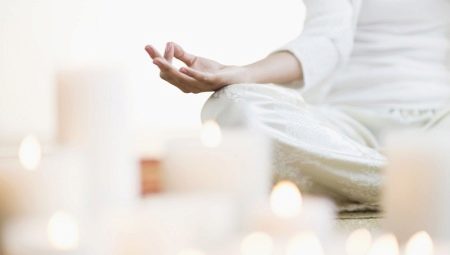How to do relaxation meditation?

Modern life requires constant stress from a person. There is no getting away from this. Going out into the street, we experience the stress of sharp car horns and other noises. Coming to work, any of us needs to focus in order to have time to earn as much money as possible. There is no rest at home either. Aggressive news is constantly broadcast on TV. Where to go from such negativity?
Relaxation meditation should be done. They will help restore peace of mind and thereby ease a difficult situation.
Stages
Experts highlight three main stages meditation. Let's consider them in more detail.
First step
The first stage is relaxation. Before entering a trance, it is necessary to release muscle tension in the shoulder girdle and neck. What you can't do is focus. Complete relaxation of the psyche requires complete disconnection from the outside world. It is necessary to remove all irritants: noise, light, uncomfortable body posture.
You can practice sitting in a chair or on the floor in a special position.... If you are not yet ready to take the Lotus position, then sit on a comfortable sofa and place a pillow under your back. In no case should you lie down and start the practice on a full stomach. Why? Because you will definitely fall asleep during the complete relaxation of the body.
And remember to keep your posture straight when seated.

Second phase
The second stage is concentration. You need to focus on any object and on its features... To do this, choose a calm place where no extraneous sounds are heard and no animals are present. So you can reduce the number of nerve stimuli and separate your consciousness from the outside world.Be aware that it is very difficult for the left hemisphere to completely disconnect from normal mental activity. Despite the relaxation of the whole body, it will still continue to function. So you everything must be done to keep this activity to a minimum... Only in this way can you direct the work of consciousness in the right direction.
Your mind will be shocked that you begin to manipulate it. It is quite possible that it will go on the offensive and try to win back its positions. Regardless, you must bring your attention to a neutral position. For this breathing exercises or music can be used... However, other methods have been invented that will allow you to concentrate quickly. The meditator may take turns fingering the tip of his thumb over the other fingers. You need to focus very strongly on this procedure. This will easily tune in to the practice. And, nevertheless, no matter how hard you try, different thoughts will swarm in your head all the time.
Don't try to fight them. Just humble yourself and breathe evenly. They will come and go, and you continue what you started.

Third stage
The third stage is contemplation or meditative state... At this stage, the right hemisphere should suppress the left, and then a holistic picture of being should be created. Thus, speculative activity stops, and consciousness is completely preserved, but moves to a new level. What do we get as a result? We disable a system that can process information from the outside. For example, in Zen practice, specialists stop speculative activity and at the same time preserve consciousness. A person, as it were, plunges into a different state, and when he returns, he sees the world around him as completely different.
All this happens because during a true trance, a person can experience such experiences that will change his worldview and the meaning of life. After leaving meditation, people begin to build new relationships, including with themselves. Meditation allows you to enter a state that helps you to come to your “I”, and from this comes awakening.

Technique
When the nervous system does not work well, then a person begins to experience various neuroses, depression, fatigue and depression. In this case, the cardiovascular system suffers. That's why it is necessary to engage in various soothing practices such as relaxation meditation. It helps to enter a state of rest and improve the functioning of the nervous system.
Respiratory
The most relaxing meditation is based on breathing. This ancient technique allows you to tune your body for healing. It is useful for both calmness and mental recovery. The best mentors came up with this method a long time ago, and now contemporaries continue to use it.
- Find a comfortable position. The back should be flat. Place your hands on your knees and point your palms up. The eyes must be closed.
- Focus on inhaling and exhaling. Feel how your lungs fill with air and even how this air, saturating your brain with oxygen, slowly exits.
- Then you need to move on to the breath holding exercise called 4x4x4. We inhale and count to 4, hold our breath and count to 4, exhale and count to 4.
After such manipulations, you can feel how all your troubles and worries go away. Enjoy a state of peace.

Audio
Listening to meditations is a fairly easy way to get into a trance.... To avoid distractions, wear headphones. In addition, meditations can contain specific frequencies. They are fully transmitted by the headphones. If it is not possible to use headphones, then simply turn on the audio recording at a volume that will be comfortable for your ears. Watch your breath carefully while meditating. Inhale the air slowly and exhale slowly.When thoughts arise, do not be distracted, try simply not to notice or skip them. In this case, the position of the body should be comfortable. If you can afford to be in the Lotus position, then so be it. Other, more sensitive people may be advised to take a reclining state in a comfortable chair.
The time of the classes can be chosen at will. However, experts say that the best hours for meditation are morning or evening. Of course, you can engage in audio meditation while sitting in a transport, but you will not feel the effectiveness of such an exercise. If you still want to practice anytime, anywhere, then listen to the sounds of nature... They are the best ways to relax your mind and body.

Visualization
To perform this kind of meditation, a person simply needs to have a good imagination. If the imagination is not developed, then this technique is able to develop visual representations in the mind, which are necessary for any sane person. What needs to be done:
- Get into a comfortable position. Use a sofa for this. For those who want to, you can sit on the floor and take the Lotus or Half-lotus pose.
- Close your eyes and imagine that you are on the seashore. You hear the waves hitting the shore. The sun's rays caress your skin. From this you warm up and glow from within.
- Get up mentally from the sand and walk along the shore. How beautiful it is here. Evergreen pines look at you from high mountains, and the sea beckons with its turquoise water.
- Feel the wind caress your face and you are happy that you are in such a beautiful and wonderful place.
- Immerse yourself in this oasis of happiness and peace.
This practice should be done whenever you get tired. So you get rid of bad mood and inner dullness.

Basic techniques
There are techniques that gave rise to meditations of various orientations. So let's take a look at them.
- For deep comprehension, also for the soul and body is carried out the practice of Metta Bhavan... By fostering love first for oneself, and then for other people, a person becomes wiser and calmer. To perform the technique, you need to breathe deeply and say to yourself: "I am happy." Ultimately, you should wish the world around you happiness and well-being. This will surround yourself with positive things.
- To relieve stress, to calm your nerves, you need to conduct meditation called Vipassana. Keep your back straight and close your eyes. Breathe evenly. Focus on your solar plexus. If bad thoughts overwhelm you, then drive them away or visually turn them into clouds that disappear. All the bad things are gone. The sun comes out. Feel complete relaxation from what you see.
- Anti-stress meditation according to Vedanta... Feel like a particle of the Universe. Close your eyes and imagine it yourself. At the same time, breathe evenly and relaxed. This technique should be done when you feel anxiety. This manipulation can be done for relaxation.
- Meditation in motion can be complete relaxation. Also, relaxation in motion will help you from stress after a hard day. When you do this technique while walking, take a breath in and out. For example, taking a breath, one foot should move and come off the floor. When you exhale, lower your foot to the floor and lean on it with all your weight. The same must be done with the other foot.

Tips for Beginners
Before you start anything, you need to seek advice from those people who have a certain experience. So, you can use the following guidelines.
- Choose a place... It should be quiet. If you are unable to find such a place, then ask your loved ones not to disturb you for a while. The room should emit light and be well ventilated. Remember that you have to breathe deeply and it is advisable that you breathe in clean air deeply.
- Also, your clothes should be comfortable... Choose the time for the practice yourself, based on your personal interests. Remember, meditation can be done at any time of the day. But it is better that it was morning or evening.
- Find a comfortable position... If you find it difficult to sit for a long time and focus on your legs and spine (as in the case of the Lotus or Half-lotus position), then use an armchair or sofa. You can use a soft pillow under your back.
There are also such poses.
- Pose in Turkish (sukhasana pose) is performed while sitting on a pillow. The back is kept straight. The palms are raised up.
- Chair pose. It is advisable to sit on the edge of a chair that has a firm seat. Place your feet flat on the floor and place your hands on your knees, palms up.

Next, let's look at a simple technique that can be applied.
- Find and get into a comfortable position.
- Concentrate on your feelings. If you feel any discomfort, fix it. For example, your leg may suddenly have a cramp. You should not endure in this case. You need to wait for the discomfort to pass, and start acting again.
- Set the alarm for 15 minutes.
- Close your eyes and start breathing deeply for "one, two, three." Repeat this exercise 5 times.
- Continue to breathe and feel your body. It should be as relaxed as your thoughts.
- Relax even more with each inhalation and exhalation. Feel the whole body. Feel the pain go away from him. Your thoughts are freed from negativity.
- Continue to keep yourself in this state. Soon you will feel how warmth spreads throughout your body, and your mind connects with the Universe.
- After the alarm goes off and you open your eyes, feel your body again. What changes do you feel? Sit and think for a few more minutes about how you felt during your meditation.
It is human nature to make mistakes. To avoid them, read the following information.
- Don't be tense during meditation. It aims to relax your body and mind.
- Don't try to shut off your thinking activity. The more you do this, the more thoughts will “swarm” in your head. Observe them from the sidelines, so to speak, abstract from them.
- Don't be biased about the meditation process. If you concentrate hard and wait for something unusual from this stage, then you will not succeed. Let the situation develop in its natural course. You will soon feel the result.
- Meditation doesn't always work out. If you are in a bad mood, you should still practice. Overpower yourself. Firstly, this way you can get rid of the negativity, and secondly, overcome your "I".
Imagine how pleased you will be if you defeat yourself.









